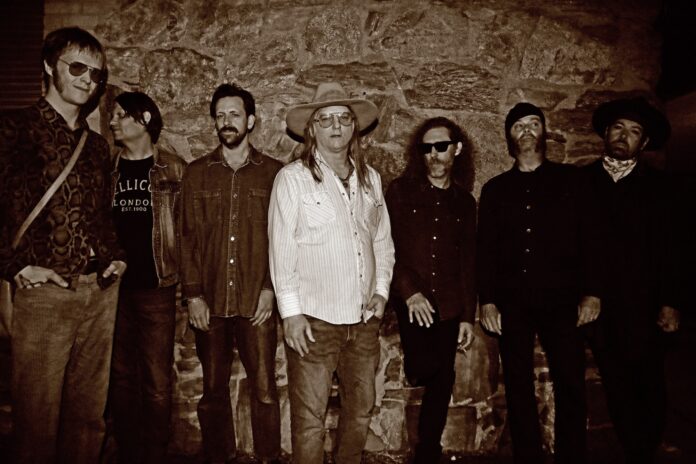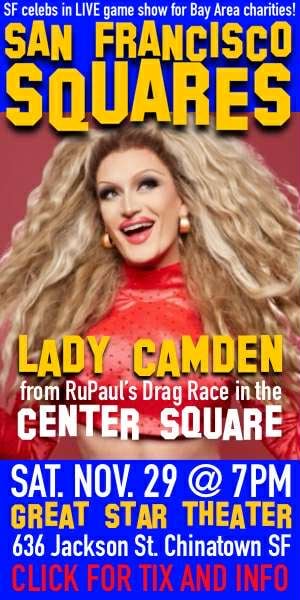The Brian Jonestown Massacre (BJM) is currently on the West Coast leg of its North American tour, moving forward with its foot on the gas. For its fearless figurehead, singer-songwriter and multi-instrumentalist Anton Newcombe, returning to San Francisco carries a particular weight.
The city is where the band first coalesced 35 years ago, born in a crucible of psychedelic rock, Haight-Ashbury idealism, and underground chaos that still echoes in its sound.
When BJM takes the stage at the Regency Ballroom (Thu/20), it won’t just be a concert—it will feel like a homecoming for one of San Francisco’s most fabled musical exports.
“It’s been quite some time since we started,” Newcombe says from Berlin, where he has lived and worked for the past 18 years. “I feel incredibly honored to be still doing what I do and to have people all over the world who genuinely tell me the music holds meaning for them.”
The setlist draws from the group’s sprawling catalog: the shimmering haze of “Anemone,” the sharp-edged swirl of “Fingertips,” the jangling melancholy of “Nevertheless,” and the pounding rush of “Super-Sonic.” With a reinvigorated rhythm section and seven musicians on stage, the band thrives on the tension between order and disorder.
The tour also honors the past—its droning, kaleidoscopic opener, “Whoever You Are,” reaches back to the group’s very first rehearsal in San Francisco in 1990, proof that the chaos of the early years still fuels the present.
Newcombe first arrived in the city in 1989 after hitching a ride with a stranger from his hometown of Newport Beach. He had less than $200 in his pocket but a firm conviction that the city was the place to make music. At the time, San Francisco was still a magnet for outsiders: punks squatting in the Mission, drag queens holding court in the Tenderloin, and aging hippies drifting along Haight Street. It was a place where ambition and misfit energy could thrive side by side.
His mother, despite their rocky relationship, surprised him with encouragement. “I hate my mom,” says Newcombe unapologetically. “She’s dead, but she was cool a couple of times. When I told her I was moving, she said, ‘Follow your dreams. And if you fuck up, you can always come live here.’”
Help us save local journalism!
Every tax-deductible donation helps us grow to cover the issues that mean the most to our community. Become a 48 Hills Hero and support the only daily progressive news source in the Bay Area.
That blessing couldn’t cover rent, though. He tried and failed to land restaurant jobs, edged out, he says, by “gay people who moved to San Francisco that were hot and had the skills.”
At one point, desperate, he called his grandmother for money for a Greyhound ticket home—only to use it to get high and keep fighting to stay afloat.
Those scrappy beginnings—renting garages in the Upper Haight, building makeshift walls out of milk crates, sleeping in cars near Golden Gate Park—formed the skeleton of the band’s San Francisco myth.
Newcombe was struggling but rarely alone. Early allies helped define what would become Brian Jonestown Massacre’s unruly spirit. Local guitarist Ricky Maymi became his right-hand man. Joel Gion was pulled from behind the counter at Reckless Records on Haight and became the group’s tambourine-wielding totem.
Guitarist Travis Threlkel, who would later co-found Obscura Digital and innovate large-scale projection art (i.e., visual experiences at Las Vegas’ Sphere), was another fixture, crashing with the band and feeding hallucinatory ideas into the mix.
“We invented it all on acid, like talking about it,” Newcombe says. “But the projecting on the sides of buildings and all that stuff was all his.”
Guitarist Jeff Davies added his own lore, living in the 503 Divisadero St. apartment where Anne Rice wrote Interview with the Vampire.
All together, they embodied the mix of vision and survivalism that gave BJM its chaotic, communal identity.
“When it got rough, I had a girlfriend who let Joel and me sleep in the back of her car,” says Newcombe. “We’d talk about how great it was going to be when everything was better. It was really about those dreams when we didn’t have anything.”
Its reputation for brilliance and volatility took root in San Francisco clubs. At North Beach’s Purple Onion—whose operator, Tom Guido, was decades later murdered in his Tenderloin apartment—the Great American Music Hall, and Bottom of the Hill, marathon sets often spiraled out of control.
Mid-song, Newcombe might lash out, swinging guitars or shoving bandmates offstage, while tambourines and amps flew. Sometimes fights spilled onto the street afterward, with Newcombe confronting hecklers or rival musicians.
Audiences came to expect that a Brian Jonestown Massacre show could deliver both transcendent psychedelia and a full-on brawl. This combustible energy became integral to the group’s Bay Area mythology.
Even in those precarious years, record labels courted the band. But Newcombe refused every offer.
“Every record label tried to sign us from the beginning, and I would tell them, ‘No,’” he says. “I saw what they were trying to do, and I was right, because none of those labels exist anymore, and nobody owns their music. But I own my music.”
His refusal to compromise was as much a part of the group’s saga as the swirling guitars and unpredictable performances.
That legend soon spilled onto film. Acclaimed documentary Dig! chronicled the band’s rivalry with The Dandy Warhols and captured the explosive energy of the Bay Area scene in the ’90s. Now marking its 20th anniversary, the film immortalized Newcombe’s chaotic charisma.
For him, shows were never just concerts but collective happenings. “When I go live, it absolutely involves everybody,” says Newcombe.”Most shows are fine, but we have our share of jerks. People want to throw rocks at the tiger or ice cubes at a cop or whatever—and it’s stupid. It just gets in the way of everybody else because I’m content not to say anything and play.”
San Francisco once embodied that kind of spontaneous communion. “It was like living in a village,” Newcombe says.
He describes grabbing coffee at Muddy Waters or the Horseshoe Cafe, then walking the neighborhood, dropping in at record stores or friends’ homes, spending whole days weaving in and out of conversations.
That web of connections has mostly vanished.
“Sometimes I wonder: do they still have great bagels on Masonic Street?” muses Newcombe. “There used to be places that I really loved, but I doubt that they exist anymore.”
These days, his life is steadier. He divides his time between the family home in Berlin—where he co-parents his 13-year-old son, Wolfgang—and a studio filled with instruments.
“Wolfgang is super cool—just a sweet person,” Newcombe says. During the pandemic, he recorded a video of his son promising never to drink or do drugs, a vow that carries extra weight in a city where parties can last for days. “Because I’m like, ‘Wait till you hear techno, man,’” says Newcombe.
He still keeps a foothold in the Bay Area with a house in Birdland, Sunnyvale, a neighborhood refuge he returns to when not on the road. “For me, that particular part of the Bay Area is really peaceful,” Newcombe says.
The Bay Area continues to inform his worldview. Growing up in a conservative Orange County household that turned born-again Christian, he watched relatives ostracize his uncle as he died of AIDS. Today, he embraces his niece’s transition without hesitation. “I want people to be happy,” he says.
His philosophy has long been one of independence and authenticity, and that bleeds into his music. “I want to be organic and free with my creativity,” says Newcombe. “It’s so important.”
BJM remains musically prolific. In the past decade alone, Newcombe has released eight full-length albums and a mini-album, including Fire Doesn’t Grow on Trees (2022) and The Future Is Your Past (2023).
Last year, he unveiled the shoegaze-infused single “Don’t Look at Me” with Aimee Nash, and earlier this year released “Makes Me Great / Out of Body,” a shimmering, percussion-heavy track praised for its hypnotic guitars and trance-like build.
San Francisco may have changed, but its imprint on Newcombe is indelible. The Haight crash pads, North Beach clubs, and Mission coffeehouses shaped both his group’s sound and his personal ethos.
“The key is, I never gave up,” Newcombe says, summing up not just his survival in San Francisco but his career as a whole.
Thirty years later, that persistence is what keeps the Brian Jonestown Massacre alive. And for one night at the Regency Ballroom, San Francisco audiences will see a band that still unapologetically channels the city’s restless, uncompromising spirit.
THE BRIAN JONESTOWN MASSACRE Thu/20. The Regency Ballroom, SF. Tickets and more info here.




